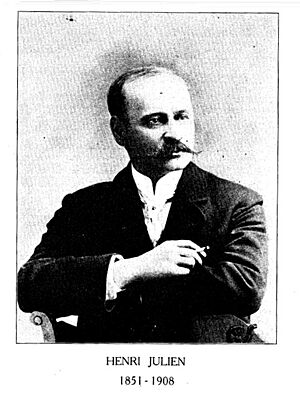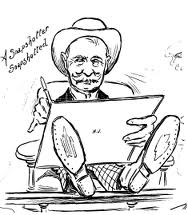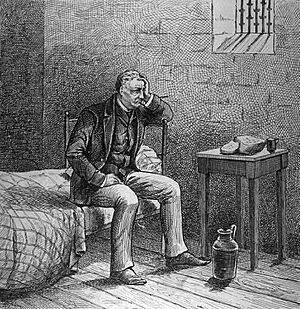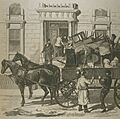Henri Julien facts for kids
Quick facts for kids Henri Julien |
|
|---|---|

Photo of Henri Julien
|
|
| Born | Octave-Henri Julien May 14, 1852 Quebec City, Province of Canada |
| Died | September 17, 1908 (aged 56) Montreal, Quebec, Canada |
| Nationality | Canadian |
| Area(s) | Cartoonist |
| Pseudonym(s) |
|
Henri Julien, whose full name was Octave-Henri Julien, was a talented Québécois artist and cartoonist. He was born on May 14, 1852, and passed away on September 17, 1908. He became famous for his drawings in the Canadian Illustrated News. He also drew many political cartoons for the Montreal Daily Star.
Henri Julien used different pen names, like Octavo and Crincrin. He was the first person in Canada to work full-time as a newspaper editorial cartoonist. This means he drew cartoons that shared opinions about news and politics.
Contents
Henri Julien's Life and Art Career
Henri Julien was born in Quebec City on May 14, 1852. He grew up in the Saint-Roch area. His father worked with printing machines. His brothers also worked in printing, showing art was in their family.
When Henri was young, he was inspired by drawings from a sculptor named Jean-Baptiste Côté. He also found ideas from the country people living near L'Ange-Gardien. These people and places influenced many of his later drawings.
His family moved often because his father worked for the Queen's printer. They lived in Toronto, Quebec City, and Ottawa. In Ottawa, he went to the College of Ottawa.
Later, he moved to Montreal. There, he learned how to be an engraver at Leggo and Company. This was a company owned by William Leggo and George-Édouats Desbarats. He met other cartoonists there, like Edward Jump. They worked for popular magazines like Canadian Illustrated News and L'Opinion publique.
Early Work and Adventures
Julien worked for Desbarats until 1888. During this time, his cartoons appeared in many other newspapers and magazines. These included Le Canard and Le Violon. He often used his pen names, Crincrin and Octavo.
His drawings included funny pictures of politicians. He also drew pictures for news stories. In 1874, he went on an adventure with George Arthur French and the North-West Mounted Police. They traveled to a place where the Bow and Belly Rivers meet in Alberta.
His drawings of the Canadian West were published in the Canadian Illustrated News. They also appeared in L'Opinion publique in 1874–75. He even drew about stopping illegal alcohol sales in Fort Whoop-Up.
Becoming a Full-Time Cartoonist
In 1888, Julien spent six months in New York. When he came back to Canada, he started working for the Montreal Daily Star. He became the artistic director there. This made the Montreal Daily Star the first Canadian newspaper to have a full-time editorial cartoonist.
Julien worked for this newspaper for 22 years. He became very well known for his work. He drew pictures for historical events and news stories. He also drew funny pictures of members of Parliament in Ottawa.
His most famous work showed rural French Canadians. He started drawing these around 1875 and continued for the rest of his life. After 1900, he also began painting. He often painted scenes from French Canadian culture. His art was shown in important exhibitions. These included shows at the Royal Canadian Academy of Arts and the Salon of the Art Association of Montreal.
Julien was known for how quickly and accurately he could draw. People admired his skill at showing feelings and movements in his art. His drawings appeared in many Canadian publications. These included Grip, Dominion Illustrated, and Canard. His work was also seen in international magazines like Harper's Weekly from the US and The Graphic from Britain.
Henri Julien married Marie-Louise Legault in Montreal in 1876. They had many children together.
Julien passed away suddenly in Montreal on September 17, 1908. He had just left the Montreal Star office. At the time, he was working on drawings for a parade. The parade was to celebrate Quebec's 300th anniversary.
Le Vieux de '37
Le Vieux de '37 means "The Old Man of '37" in French. This is the name of a famous drawing by Henri Julien. He created it around 1880. The drawing was made to illustrate a poem called Le vieux patriote by Louis Fréchette.
The drawing shows a person who took part in the Lower Canada Rebellion. This rebellion happened in 1837 and 1838. People in Lower Canada (which is now Quebec) wanted to become a democratic republic. They wanted to be independent from the British Empire.
Today, Le Vieux de '37 is one of the most famous symbols of that rebellion. It became an important symbol for groups who wanted Quebec to be independent. You can sometimes see this image on some Patriote flags.
Henri Julien's Legacy
The sculptor Louis-Philippe Hébert said that Julien had "the most original talent in this country." After Julien's death, a collection of his cartoons was published in 1916. It was called Album Henri Julien.
In 1936, an exhibition of 125 of Julien's drawings was shown. It traveled to Montreal, Toronto, Ottawa, and Quebec City. The National Gallery of Canada also held a special show of Julien's work in 1938. This was a rare honor for a cartoonist in Canada.
A print by Henri Julien showing the uniform of cadets from the Royal Military College of Canada is in the Canadian War Museum in Ottawa, Ontario. The gallery L'Art français also showed his works in 1968.
The Musée national des beaux-arts du Québec has the largest collection of Julien's art. This includes La Chasse-galerie, which is Julien's most famous painting. It was inspired by a French-Canadian legend about a flying canoe.
Books with Henri Julien's Art
- Sous les pins (1902) – This book was written by Adolphe Poisson. It included drawings by Julien.
- La légende d'un peuple (1908) – Written by Louis-Honoré Fréchette, with illustrations by Julien.
- Album Henri Julien (1916) – A collection of Henri Julien's own cartoons.
Images for kids








